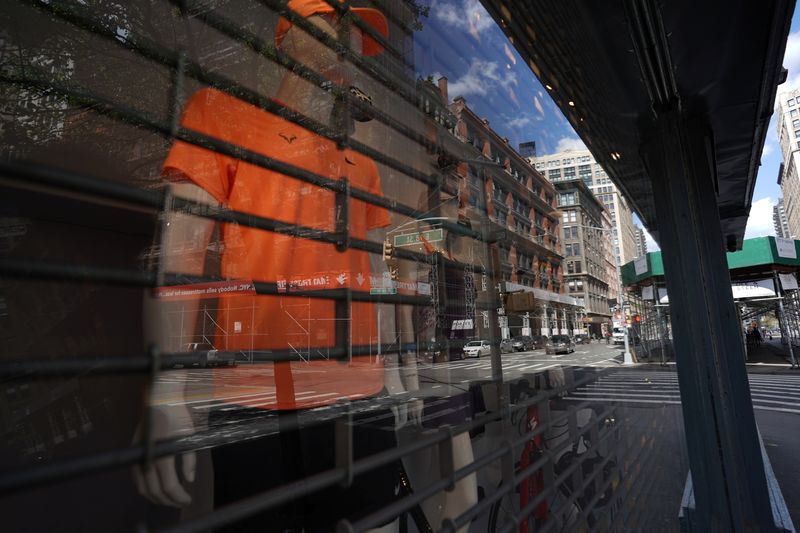WASHINGTON (Reuters) – U.S. consumer confidence tumbled to near a six-year low in April as tough measures to curb the spread of the novel coronavirus sharply disrupted economic activity and threw millions of Americans out of work.
Other data on Tuesday showed the global pandemic was severely limiting the flow of goods between countries, with exports from the United States collapsing and imports from other nations continuing to decline. The reports strengthened economists’ views that the economy was in a deep recession.
The government is scheduled on Wednesday to publish its snapshot of first-quarter gross domestic product. According to a Reuters survey of economists, GDP likely contracted at a 4.0% annualized rate in the January-March quarter, which would be the steepest pace of decline since the Great Recession and end a record 11 straight years of growth. The economy grew at a 2.1% rate in the fourth quarter.
“The deeper the hole the economy digs, the harder it is going to be for consumers and businesses to climb back out,” said Chris Rupkey, chief economist MUFG in New York. “World trade volumes are going to come off further this year which reminds us of the Great Depression.”
The Conference Board said its consumer confidence index dropped to a reading of 86.9 this month, the lowest since June 2014, from 118.8 in March. Economists polled by Reuters had forecast the index would fall to 87.9 in April.
The Conference Board survey’s present situation measure, based on consumers’ assessment of current business and labor market conditions, tumbled a record 90 points to a reading of 76.4 this month. But the expectations index, which is based on consumers’ short-term outlook for income, business and labor market conditions, increased to 93.8 from a reading of 86.8.
The Conference Board attributed the improvement in expectations to “the possibility that stay-at home restrictions will loosen soon, along with a re-opening of the economy.”
States and local governments have issued “stay-at-home” or “shelter-in-place” orders affecting more than 90% of Americans to control the spread of COVID-19, the respiratory illness caused by the virus, and almost shutting down the country. Some have started to reopen their economies, while others have started easing some restrictions on movement.
Stocks on Wall Street were trading largely higher, lifted by a string of upbeat quarterly reports and hopes of a pickup in activity as regional economies slowly reopen. The dollar <.DXY> fell against a basket of currencies, while longer-dated U.S. Treasury prices were trading higher.
SHARP DETERIORATION
Despite the improvement in expectations, households remained worried about their finances, which could keep consumer spending subdued. About 26.5 million people have filed for unemployment benefits since March 21.
The Conference Board’s so-called labor market differential, derived from data on respondents’ views on whether jobs are plentiful or hard to get, tumbled to -13.6 in April, the lowest reading since July 2014, from 29.5 in March.
That measure closely correlates to the unemployment rate in the Labor Department’s employment report.
The sharp decline in April, together with a wave of layoffs, buttresses economists’ expectations that the unemployment rate will shatter the post-World War Two record of 10.8% touched in November 1982. The jobless rate shot up 0.9 percentage point, the largest monthly change since January 1975, to 4.4% in March.
The percentage of consumers expecting an increase in income declined to 16.7% this month from 20.0% in March and the proportion anticipating a drop rose to 18.5% from 10.1%.
In a separate report on Tuesday, the Commerce Department said the goods trade deficit increased 7.2% to $64.2 billion last month. While a shrinking import bill is a positive in the calculation of GDP, declining imports mean less inventory accumulation, which could offset trade’s contribution to GDP.
Economists believe the economy entered recession in March. The National Bureau of Economic Research, the private research institute regarded as the arbiter of U.S. recessions, does not define a recession as two consecutive quarters of decline in real GDP, as is the rule of thumb in many countries. Instead, it looks for a drop in activity, spread across the economy and lasting more than a few months.
In March, goods imports dropped 2.4% to $191.9 billion after decreasing 2.5% in February. Goods imports tumbled 9.6% in March from a year ago. There were sharp decreases in imports of consumer goods and motor vehicles and parts. Imports of food, industrial supplies and capital goods rose last month.
Exports of goods plunged 6.7% to $127.6 billion in March. There was a broad decline in exports last month, with shipments of industrial supplies dropping 7.5% and motor vehicles and parts plummeting 17.8%.
“Further deterioration is likely,” said James Watson, a senior economist at Oxford Economics in New York. “With global and domestic demand contracting amid the sharpest downturn post WWII, trade will be among the sectors hit hardest.”
The decline in motor vehicle exports boosted retail inventories, which jumped 0.9% in March after dropping 0.4% in February. Motor vehicle and parts inventories surged 5.1% after falling 0.9% in the prior month.
Retail inventories, excluding motor vehicles and parts, the component that goes into the calculation of GDP, plunged 1.3% last month after slipping 0.2% in February. Wholesale stocks dropped 1.0% in March after falling 0.6% in the prior month.
A third report on Tuesday showed the S&P CoreLogic Case-Shiller 20-metro-area house price index increased 3.5% from a year ago in February after rising 3.1% in January.
House price inflation could ease as record high unemployment slows demand for homes. Homebuilding dropped by the most in 36 years in March, the government reported this month.
(Reporting by Lucia Mutikani; Editing by Chizu Nomiyama and Paul Simao)






















